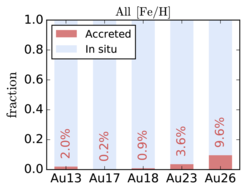Our Milky Way – not a typical spiral galaxy
By examining the Auriga suite, a large sample of simulated Milky Way galaxies formed in the full cosmological context, scientists at MPA have been able to place constraints on the history of the Milky Way's formation. By comparing these simulations to observations of the Milky Way — and specifically to how fast stars of different metallicities in the inner regions of the Galaxy move around its centre — they were able to exclude certain formation histories. In particular they found that our galaxy had to be quite isolated with the last major merger happening over 12 billion years ago and with a galaxy less than 10% of the mass of the Milky Way.

The simulated galaxy from the Auriga suite in this image is similar to our Milky Way: in shows a clear spiral structure with an elongated stellar bar at the centre.
In the Milky Way, stars in the central regions move on elongated orbits, which collectively form a structure called a “stellar bar" cutting through the centre of our galaxy (see Figure 1 and Video). Furthermore, when the disc of the Milky Way is viewed from the side, the bar appears to have a distinctive “X”, or peanut-shape, leading to it being called a boxy/peanut bulge. (Bulges get their name from the fact that they “bulge”, or stick out of, the plane of the disc.) The MPA scientists looked for signatures of such bars and peanuts in their simulations and found that a fair fraction of the simulated galaxies formed these structures. They then explored in detail the properties of these galaxies as a function of their merger history, i.e. how often other galaxies were swallowed up by the simulated Milky Way.
In order to match the highly ordered rotation of stars in the Milky Way, the simulated galaxies must have had a very “quiescent” merger history in the last 12 billion years. This means that no galaxy with a mass larger than 10% the mass of the Milky Way can have collided with our Galaxy in this time. This is because when a massive galaxy collides with another, the orbits of their stars get “messed up”, which leads to less ordered motion, and therefore higher velocity dispersion. As galaxies are built up by small galaxies merging into each other and forming bigger and bigger structures over time this means that the Milky Way has to be a very isolated, and therefore rare, galaxy in the Universe. The scientists found that only 2 out of 40 of their simulated galaxies have properties matching the Milky Way, further pointing to the fact that our home galaxy is probably an “outlier” in the grand scheme of galaxy formation.
The orbits of stars in barred spiral galaxies
This study helps place constraints on a rather cataclysmic event in the life of our Galaxy. From the groundbreaking second Gaia data release (Gaia DR2), it was discovered that the Milky Way likely underwent a merger with another galaxy (dubbed Gaia Enceladus) about 9 billion years ago, which is thought to be the last significant merger in the Milky Way’s history. However, the mass of Gaia Enceladus is still being debated. Therefore, with this study, MPA scientists are able to place an upper limit on the mass of Gaia Enceladus, showing that it could have only been up to 10% as massive as the Milky Way, and was likely as small as 3%.

For five simulated galaxies, this plot shows where the stars in the inner regions were born: either in other galaxies that merged with the galaxy (a small fraction) or in-situ (the vast majority).
Furthermore, the scientists traced where stars in the inner regions of their best-matching simulated Milky Ways were born and they found that over 99% of these stars were born “in-situ”, i.e. in the disc of the Milky Way (see Figure 2). This is contrary to what scientists had assumed previously, namely that the stars in the inner regions of the Milky Way, i.e. the so-called “bulge”, were formed in other galaxies that smashed onto the Milky Way.
The MPA scientists also examined how the bars affect the outer parts of their host galaxies and found that they create ripples and undulations in their host discs. Such ripples have also been discovered in the disc of the Milky Way with Gaia DR2, and the scientific community is still struggling to explain how they were formed. By comparing some specific features in the ripples, which arise at given locations in the disc depending on the bar rotation, the scientists will be able to determine how fast the bar of our Milky Way rotates. This will help to explain what gave rise to the observed ripples and undulations we see in the Milky Way’s disc, thus deciphering the structure of our host Galaxy.













